Jessica M. Mueller, Dr. Mark D. Schmitz
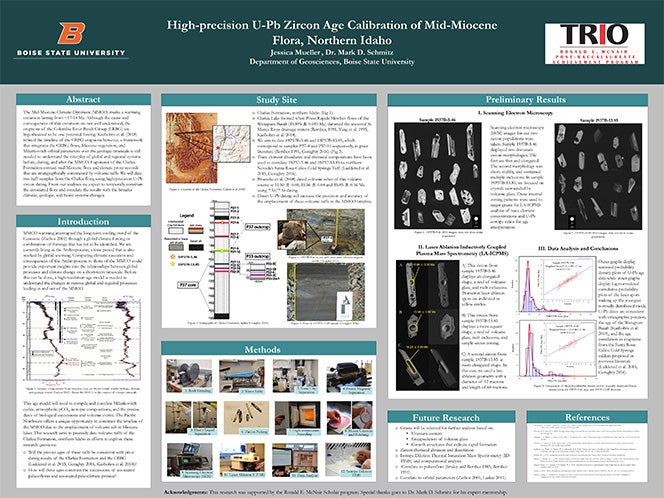
Abstract
The Mid-Miocene Climatic Optimum (MMCO) marks a warming excursion lasting from ~17-14 Ma. Although the cause and consequences of this excursion are not well understood, the eruptions of the Columbia River Basalt Group (CRBG) are hypothesized to be one potential forcing. Kasbohm et al. (2018) refined the timeline of the CRBG eruptions however, a framework that integrates the CRBG flows, Miocene vegetation, and Milankovitch orbital parameters over the geologic timescale is still needed to understand the interplay of global and regional systems before, during, and after the MMCO. Exposures of the Clarkia Formation contain mid-Miocene flora and climate proxy records that are stratigraphically constrained by volcanic tuffs. We will date two tuff samples from the Clarkia flora, using high-precision U-Pb zircon dating. From our analyses we expect to temporally constrain the associated flora and correlate the results with the broader climatic, geologic, and biotic systems changes.
Introduction
MMCO warming interrupted the long-term cooling trend of the Cenozoic (Zachos 2001) through a global climate forcing or combination of forcings that has yet to be identified. We are currently living in the Anthropocene, a time period that is also marked by global warming. Comparing climatic causation and consequences of the Anthropocene to those of the MMCO could provide important insights into the relationships between global processes and climate change on a short-term timescale. Before this can be done, a high-resolution age model is needed to understand the changes in various global and regional processes leading in and out of the MMCO.
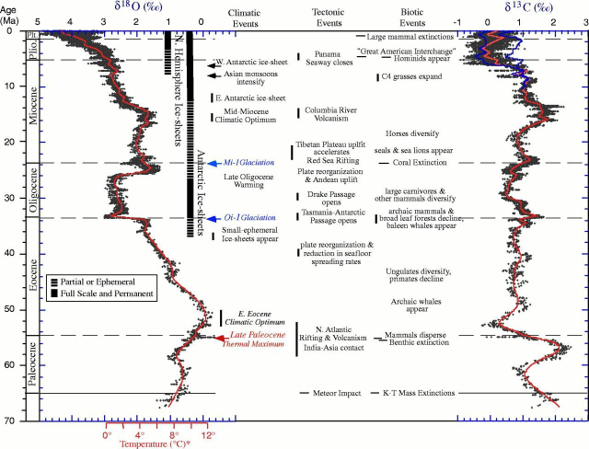
This age model will need to compile and correlate Milankovitch cycles, atmospheric pCO2, isotopic compositions, and the precise dates of biological successions and volcanic events. The Pacific Northwest offers a unique opportunity to constrain the timeline of the MMCO due to the emplacement of volcanic ash in Miocene lakes. This research aims to precisely date volcanic tuffs of the Clarkia Formation, northern Idaho in efforts to explore these research questions:
- Will the precise ages of these tuffs be consistent with prior dating results of the Clarkia Formation and the CRBG (Laddered et al. 2015, Geraghty 2016, Kasbohm et al. 2018)?
- How will these ages constrain the successions of associated palaeofloras and associated paleoclimate proxies?
Study Site
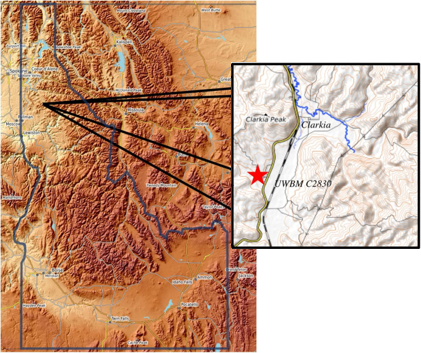
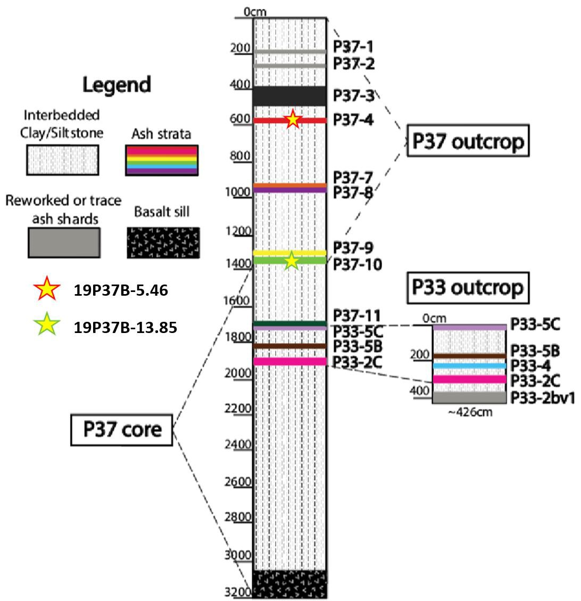
- Clarkia Formation, northern Idaho (Fig 1)
- Clarkia Lake formed when Priest Rapids Member flows of the Wanapum Basalt (15.895 ± 0.019 Ma) dammed the ancestral St. Maries River drainage system (Rember, 1991, Yang et al. 1995, Kasbohm et al. 2018).
- We aim to date 19P37B-5.46 and 19P37B-13.85, which correspond to samples P37-4 and P37-10 respectively, in prior literature (Rember 1991, Geraghty 2016) (Fig 3).
- Trace element abundance and chemical compositions have been used to correlate 19P37-5.46 and 19P37-13.85 to northern Nevada’s Santa Rosa-Calico Cold Springs Tuff (Ladderud et al. 2015, Geraghty 2016).
- Brueseke et al. (2008) dated volcanic ashes of this volcanic source at 15.50 ± 0.08, 15.56 ± 0.04 and 15.85 ± 0.16 Ma using 40Ar/39Ar dating.
- Direct U-Pb dating will increase the precision and accuracy of the emplacement of these volcanic tuffs in the MMCO timeline.
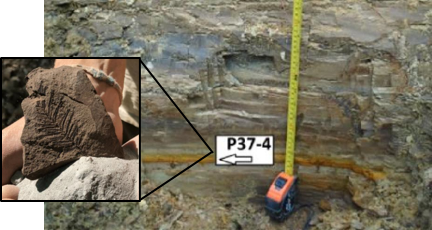
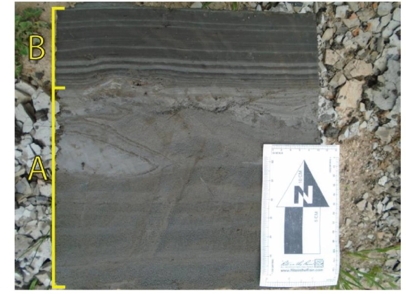
Methods

- Rock Grinding
- Water Table
- Sonic Clay Separation
- Frantz Magnetic Separation
- Heavy Liquid Separation
- Zircon Picking
- High-temperature Annealing
- Mount Creation and Polishing
- Scanning Electron Microscope (SEM)
- Laser Ablation ICP-MS
- Data Analysis
- Isotope Dilution TIMS
Preliminary Results
I. Scanning Electron Microscopy
Scanning electron microscopy (SEM) images for our two zircon populations were taken. Sample 1937B-5.46 displayed two dominant zircon morphologies. The first are thin and elongated. The second morphology was short, stubby, and contained multiple inclusions. In sample 19P37B-13.85, we focused on crystals surrounded by volcanic glass. These internal zoning patterns were used to target grains for LA-ICPMS analysis of trace element concentrations and U-Pb isotope ratios for age interpretation.

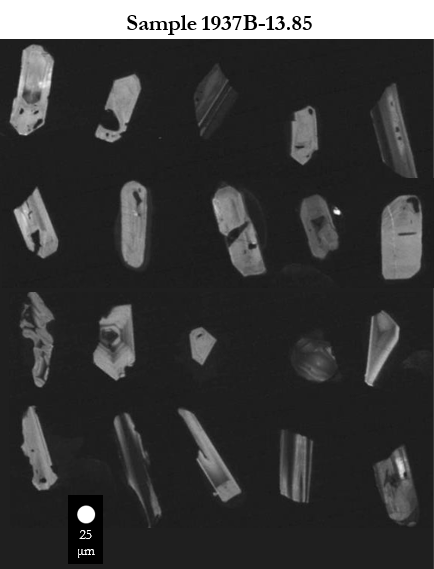
II. Laser Ablation Inductively Coupled Plasma Mass Spectrometry (LA-ICPMS)

A) This zircon from sample 1937B-5.46 displays an elongated shape, a rind of volcanic glass, and melt inclusions. 25-micron laser ablation spots are indicated in yellow circles.
B) This zircon from sample 1937B-13.85 displays a more equant shape, a rind of volcanic glass, melt inclusions, and simple sector
C) A second zircon from sample 1937B-13.85. is more elongated shape. In this case we used a line ablation geometry with a diameter of 12 microns and length of 60 microns.
III. Data Analysis and Conclusions
Outer graphs display summed probability density plots of U-Pb age data while inner graphs display log-normalized cumulative probability plots of the laser spots making up the youngest normally distributed mode. U-Pb dates are consistent with stratigraphic position, the age of the Wanapum Basalt (Kasbohm et al. 2018), and the age correlation to eruptions from the Santa Rosa- Calico Cold Springs caldera proposed in previous literature (Ladderud et al. 2015, Geraghty 2016).
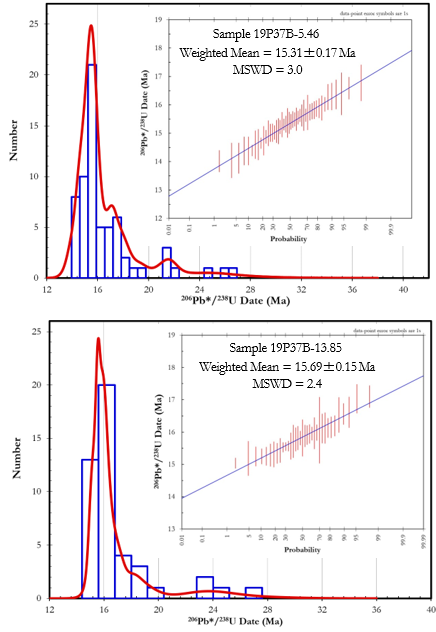
Future Research
Grains will be selected for further analysis based on:
- Uranium content
- Encapsulation of volcanic glass
- Growth structures that indicate rapid formation
Zircon chemical abrasion and dissolution
Isotope Dilution Thermal Ionization Mass Spectrometry (IDTIMS) and computational analysis
Correlate to palaeoflora (Smiley and Rember 1985, Rember 1991)
Correlate to orbital parameters (Zachos 2001, Laskar 2011)
References
- Calede, J.J.M., Orcutt, J.D., Kehl, W.A., Richards, B.D. (2018). The first tetrapod from the mid-Miocene Clarkia lagerstätte (Idaho, USA). PeerJ, 6:e4880 https://doi.org/10.7717/peerj.4880
- Brueseke, M. E., Hart, W. K. (2008). Geology and petrology of the mid-Miocene Santa Rosa-Calico volcanic field, northern Nevada. Nevada Bureau of Mines and Geology 113.
- Geraghty, C. S., Wolff, J. A., Gaylord, D. R., Neill, O. K., Rember, W. C. (2016). Tephrochronology Of Mid-Miocene Clarkia Lake. doi: 10.1130/abs/2016am-286182
- Kasbohm, J., Schoene, B. (2018). Rapid eruption of the Columbia River flood basalt and correlation with the mid-Miocene climate optimum. Science Advances, 4(9). doi: 10.1126/sciadv.aat8223
- Ladderud, J. A., Wolff, J. A., Rember, W. C., & Brueseke, M. E. (2015). Volcanic Ash Layers in the Miocene Lake Clarkia Beds: Geochemistry, Regional Correlation, and Age of the Clarkia Flora. Northwest Science, 89(4), 309–323. doi: 10.3955/046.089.0402
- Rember, W. C. (1991). Stratigraphy and paleobotany of Miocene Lake sediments near Clarkia, Idaho. University Microfilms International.
- Smiley, C. J., Rember, W. C., (1985). Physical setting of the Miocene Clarkia fossil beds, Northern Idaho. In: Smiley, C.J. (Ed.), Late Cenozoic History of the Pacific Northwest. Pacific Division of the American Association for the Advancement of Science, San Francisco, pp. 11–31.
- Yang, H., Smiley , C. J., Sprenke, K. F., Rember, W. C. (1995). Subsurface evidence for a rapid formation of the Clarkia Miocene lake in northern Idaho. Northwest Science, 69, 52-59.
- Zachos, J. (2001). Trends, Rhythms, and Aberrations in Global Climate 65 Ma to Present. Science, 292(5517), 686–693. doi: 10.1126/science.1059412
- Laskar, J., Fienga, A., Gastineau, M., & Manche, H. (2011). La2010: a new orbital solution for the long-term motion of the Earth. Astronomy & Astrophysics, 532. doi: 10.1051/0004-6361/201116836
Acknowledgements
This research was supported by the Ronald E. McNair Scholar program. Special thanks goes to Dr. Mark D. Schmitz for his expert mentorship.
Additional Information
For questions or comments about this research, contact Jessica Mueller at jessicamueller@u.boisestate.edu.